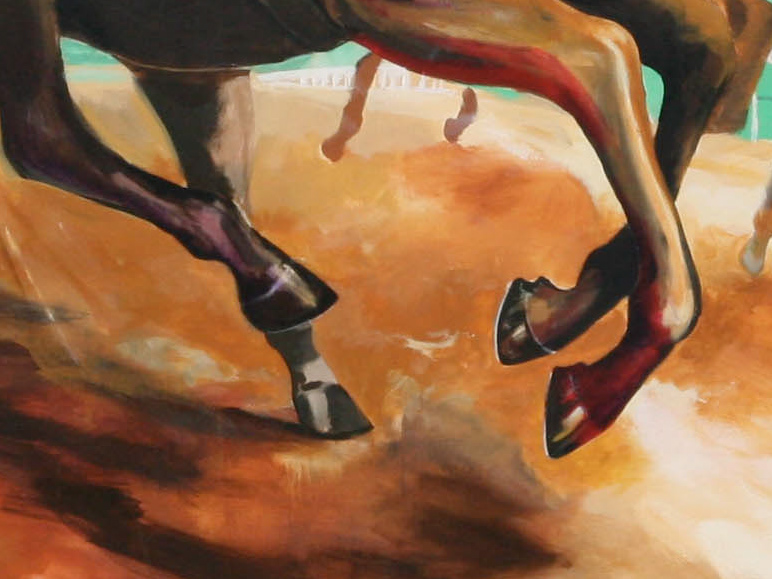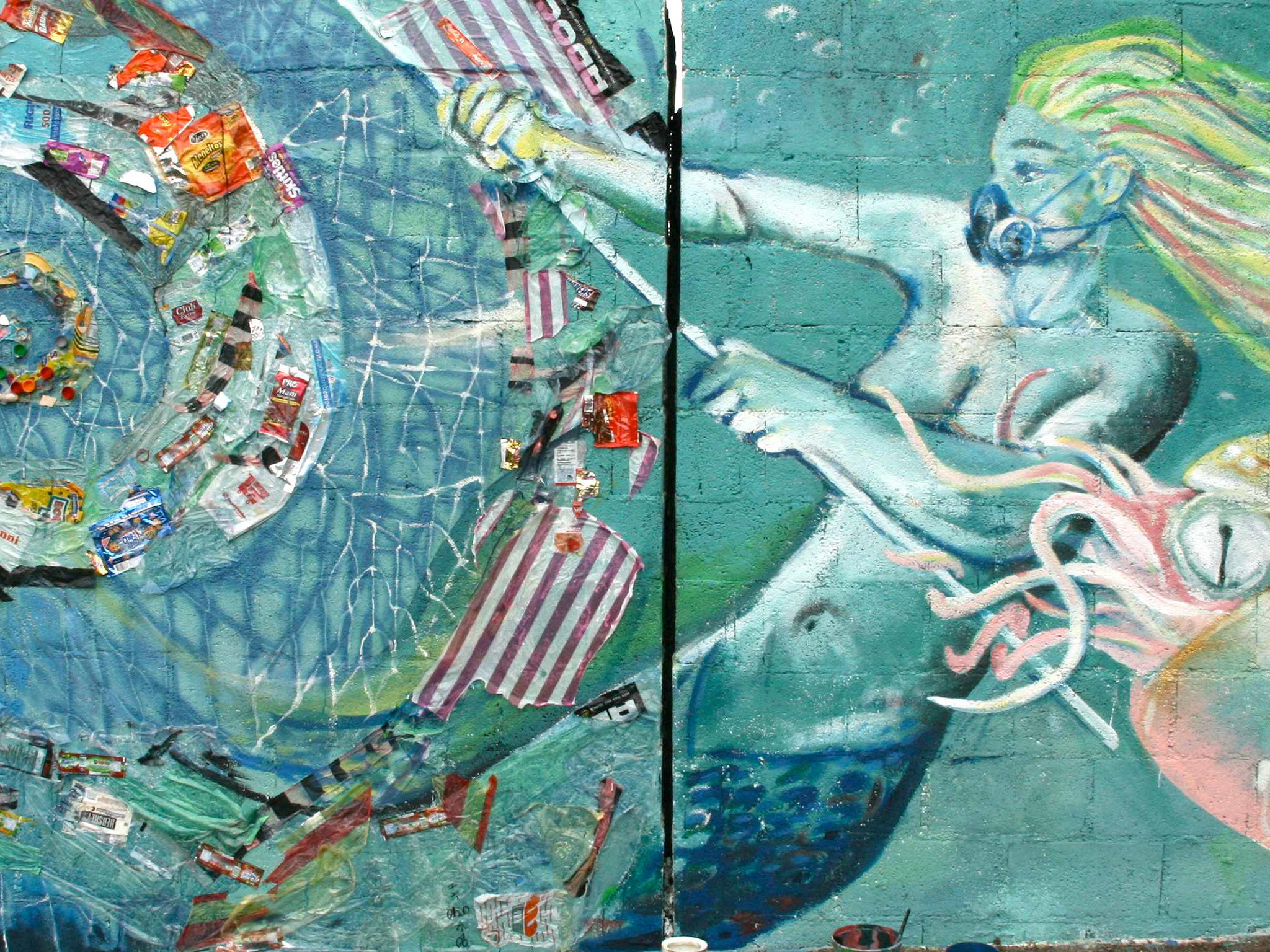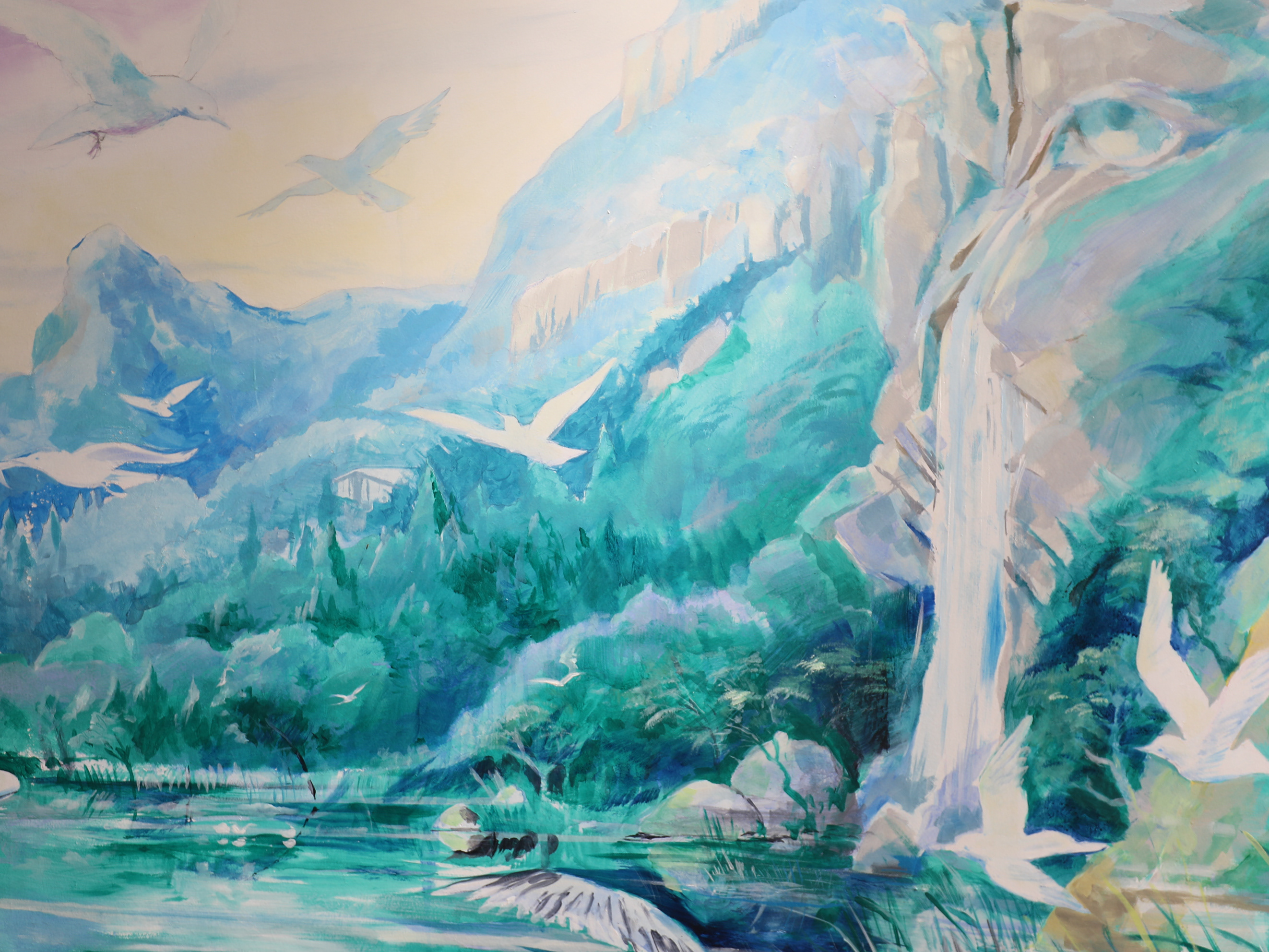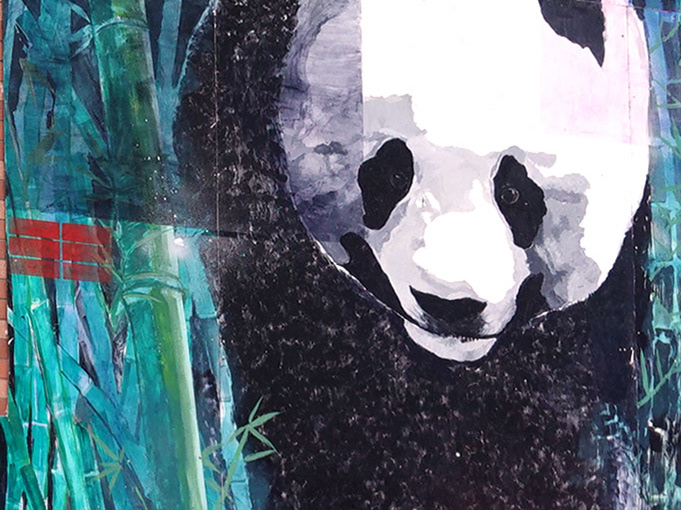Growing Community to Protect the Biosphere
It was gratifying to feel the growing sense of community solidarity with our cause to protect the biosphere, while working on the mural. Many neighbors and people passing by on foot, bike or car stopped to share their support. Young and old honked their horns and waved in appreciation. Some local folks and neighbors who could read ‘Biosphere’ in their native languages, such as Hindi and Arabic, stopped and shared their appreciation of the mural, and helped us with some details of the script. The 12 languages depicted in the mural, going from top to bottom are: Icelandic, Greek, Russian, Spanish, German, English, Swahili, Hindi, Arabic, Thai, Korean, Chinese/Japanese.
One of the unusual and memorable comments, made by a number of people passing was, “It’s great, what is it?” So just in case any doubts remain, here’s the answer. The mural depicts an image of Earth as seen from space, focusing on the blue membrane of life encircling the planet, the Biosphere. The Biosphere is made up of all regions of Earth where life exists from the deepest root systems of trees, to the darkest ocean trenches, and up to our highest mountain tops. This narrow band, teeming with life forms, measures 20 kilometers from top to bottom. But almost all the biodiversity on earth exists in the section between 500 meters below the ocean surface to about six kilometers above sea level. The biosphere is a global ecological system integrating all living beings and their relationships including their interactions with the lithosphere, hydrosphere, and atmosphere. This mural was commissioned by 350 Eugene as part of their ongoing work to help Eugene reduce its carbon footprint and organize our community to protect Earth’s biosphere.
The Pacific Coastline of North America and Oregon
This particular perspective of the Earth shows Alaska, the Aleutian Peninsula, and the Pacific coastline of Canada, Washington and Oregon. I chose this view of Earth from space because the long chain of islands forms a curving shape in the Pacific Ocean. The angle of the islands compliments the curvature of the biosphere, bending in the opposite direction. This view also allowed me to address the issue of climate change impacting the Arctic, while also extending our focus of concern down the Pacific coast to Eugene, which is included in the mural at the western corner of the wall. And this perspective permitted me to include the eastern tip of Asia to convey more of the global community. A global perspective is also encouraged with the translation of “Biosphere” into 10 other languages.
The Blue Pacific Ocean
The presence of water on our planet has made all the difference in creating the conditions for life on Earth, the formation of the biosphere, and the evolution of humanity within it. The mural pays homage to the role the oceans have played in creating our biosphere. I painted swirling shapes in the Pacific in various hues of blue, green and purple to represent the great upwellings of plankton species that form the foundation of the food chain for life on land and water. Besides feeding everything from sardines to whales, many kinds of plankton species create much of the oxygen in the air, on which all life depends. Wind currents of air also affect the changing weather patterns of our seasons. These are represented by the cloud formations which swirl over land and sea, echoing the currents in the ocean. Finally, the open skies in the mural are filled with flocks of snow geese, gulls, and other migrating birds in their annual migration towards the arctic.
Animal Spirits in the Aurora Borealis
The large animals depicted in the center of the mural serve a symbolic purpose in the mural. The shapes of these animals were created by painting clusters of stars in the night sky to form the animals’ faces; they float above the earth as if in the milky way. The numinous colors of an aurora borealis also flares around them. The phenomena of an aurora borealis is created when solar flares crash into the ionosphere. The ionosphere is the outermost layer of our atmosphere which protects our biosphere. Thus, metaphorically these animal images represent the shield of the ionosphere protecting us from above. Their faces were created by using a stencil of each animal figure and various airbrush techniques to create an ephemeral look. The eyes of the animals seek our attention with their intense gaze as if asking us, will you help protect our home and our lives from the climate crisis? Their direct stares are pained and wary, watching us as we pass by.
I painted the polar bear and placed her next to the arctic seal because even though it is the largest land carnivore on the planet—the apex predator of the arctic—polar bears are dependent for their survival on seal populations and arctic sea ice. Narwhals, also a species whose existence has been protected by sea ice, are newly threatened by climate change and the arrival to the region, of species such as Orcas. The deer is an iconic species of Alaska, Oregon and many northern hemispheric regions, whose regal antlers serve as a complementary element to the narwal’s tusk. Both of these animals play mythical roles in many cultural stories and their shapes help to punctuate the vastness of dark, outer galactic space. The large cat staring down from above is a jaguar. Jaguars are the largest felines in the Americas. Their native range used to approach the arctic. This cat’s bright, sad eyes look south towards the tropical regions of the American continent where the species still survives. The inclusion of the jaguar, sacred to many people in Central America, reflects my Costa Rican heritage, as well as the wandering spirit that many humans share with wide-ranging animal species
Running the Race to Protect Life on Earth
The smaller set of animals stenciled on the east end of the mural were initially painted as an artistic experiment. They allowed us to try out stencil designs on the wall's surface before painting the larger images while working on scaffolding. We decided to leave these images since their placement appeals to younger children. Also, the animals are running in the biosphere to remind us of the fact that life on Earth is a struggle that only exists within this fragile, inhabitable membrane encircling the planet. The larger running figure was included in the mural to coincide with the July 2022 World Athletic Championships Meet held in Eugene. This runner symbolizes our current predicament: we must endeavor to give our utmost to this global challenge to protect the Biosphere. We must engage in the work with the same degree of commitment showed by the great athletes of the world, such as Oregon’s own Steve PreFontaine.
Intergenerational Activism and Building Community
I have been painting images of the earth and nature for activist causes in Oregon since I was in middle school. In 2003, my family was active in the antiwar movement trying to stop the invasion of Iraq. At that time, my mother helped organize Friendly Neighbors for Peace, to educate folks locally and create yard signs against the war. At one of their sign-making events, my grandmother asked me to make a sign with a dove on it. My mother wanted the dove to carry the earth on its back. From this hand-made sign for my grandmother, I later created a design which was mass produced for Friendly Neighbors for Peace. Thousands of these signs were distributed in Eugene and Oregon to help citizens protest that war and others.
This intergenerational collaboration of family members continues and it was part of the inspiration that made this mural possible. My mother, Kara Steffensen, collaborated with me on the design and painting of the Biosphere mural. The intragenerational tradition of activism for global causes of peace and justice is a legacy coming from my grandmother, grandfather, mother and other members of our family. Lending our artistic skills to these struggles in the form of sign-making, poetry, and murals is another way of participating in these causes and creating a legacy of continuing activism.
Where did the concept for the Biosphere Mural originate?
The early sketches for the Biosphere mural began with an entirely different idea related to cycling. The first drafts were about immense bicycle wheels with images of sustainability around them. While working on these sketches, I realized that the wheel was a shape that could be extended over the entire wall to unify its long, somewhat rambling nature. The arch of the wheel then morphed into the curvature of the earth as seen from space. This large image of the planet was also inspired by the previous mural on the same wall, painted in 2013 with a group of children and Our Children’s Trust. This original mural featured a bicycle where the front wheel was the earth, and the back wheel was an iceberg and polar bear. Two young plaintiffs were holding hands in the middle. Part of the art from that mural was preserved and incorporated into the new design to continue to honor the work of Our Children’s Trust.










